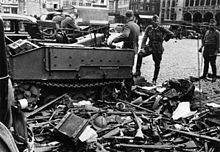German invasion of Belgium (1940)
| Battle of Belgium | |||||||||
|---|---|---|---|---|---|---|---|---|---|
| Part of the Western Front of World War II | |||||||||
 German soldiers pictured with a Vickers Utility Tractor (VUT) of the Belgian Army, and a pile of Belgian rifles and helmets the day after the Belgian surrender, 29 May 1940 | |||||||||
| |||||||||
| Belligerents | |||||||||
|
|
| ||||||||
| Commanders and leaders | |||||||||
|
|
| ||||||||
| Strength | |||||||||
|
144 divisions[Notes 2] 13,974 guns[Notes 3] 3,384 tanks[Notes 4] 2,249 aircraft[Notes 5] |
141 Divisions[2] 7,378 guns[2] 2,445 tanks[2] 5,446 aircraft (4,020 operational)[2] | ||||||||
| Casualties and losses | |||||||||
|
222,443+ casualties (200,000 captured)[Notes 6] ~900 aircraft[Notes 7] | Unknown (see German casualties)[Notes 8] but at least 43 paratroopers were killed and a further 100 wounded.[11] | ||||||||
The Battle of Belgium or Belgian Campaign was part of the greater Battle of France. This was an offensive campaign by Germany during the Second World War. It took place over 18 days in May 1940. It ended with the German occupation of Belgium following the surrender of the Belgian Army.
The Allied Armies tried to stop the German Army in Belgium. They thought it was the main German attack. After the French had fully committed the best of the Allied Armies to Belgium between 10 and 12 May, the Germans went towards the English Channel. The German Army reached the Channel after five days. They encircling the Allied Armies. The Germans forced the Allies back to the sea. The Belgian Army surrendered on 28 May 1940, ending the battle.[12]
The Battle of Belgium included the first tank battle of the war.[13] It was the largest tank battle in history up to that date. The battle also included the Battle of Fort Eben-Emael, the first strategic airborne operation using paratroopers.
Belgium was occupied by the Germans until the winter of 1944–1945. It was freed by the Western Alliance.
Notes
[change | change source]- ↑ Contributed lightly armed infantry units retreating from Dutch territory. Also committed the Dutch Air Force on few, ineffective and costly missions.[1]
- ↑ The Belgian Army consisted of 22 divisions, the French provided 104, the British provided 10, and the Dutch 8 divisions.[2]
- ↑ The Belgian Army had 1,338 guns, the French 10,700, the British 1,280, and the Dutch 656.[2]
- ↑ The Belgian Army had 10 tanks, the French 3,063, the British 310 and the Dutch 1 tank.[2]
- ↑ The Belgian Air Force consisted of 250 aircraft, the French Air Force 1,368, the British Royal Air Force provided 456 aircraft and the Dutch Air Force 175.[2]
- ↑ The Belgian Army sustained 6,093 men killed, 15,850 men wounded in action, more than 500 men missing and 200,000 men captured, of which 2,000 died in captivity.[3][4] French and British losses on Belgian territory are unknown.[5]
- ↑ The Belgian Air Force lost 83 planes on the ground on 10 May,[6] 25 lost in aerial combat between 10–15 May,[7] and four lost in the air between 16–28 May.[8] French and British losses are not certain, however the French Air Force lost 264 aircraft between 12–25 May and 50 for 26 May – 1 June while the British Royal Air Force lost 344 and 138 aircraft in these respective periods.[9]
- ↑ German air units doubled up and flew missions over the Netherlands and Belgium. Case specific loss totals for Belgium only cannot be certain. Total German losses in the air numbered 469 in 12–25 May, and 126 for 26 May – 1 June.[10]
References
[change | change source]- ↑ Gunsburg 1992, p. 216.
- ↑ 2.0 2.1 2.2 2.3 2.4 2.5 2.6 2.7 Holmes 2005, p. 324.
- ↑ Keegan 2005, p. 96.
- ↑ Ellis 1993, p. 255.
- ↑ Keegan 2005, p. 326.
- ↑ Hooton 2007, p. 52.
- ↑ Hooton 2007, p. 49.
- ↑ Hooton 2007, p. 53.
- ↑ Hooton 2007, p. 57.
- ↑ Hooton 2007, p. 57
- ↑ Dunstan 2005, p. 57
- ↑ Shirer 1990, p. 729.
- ↑ Healy 2007, p. 36.
